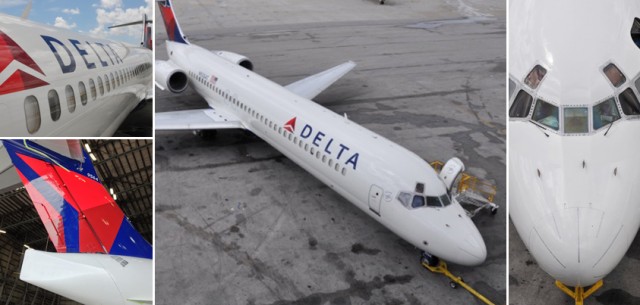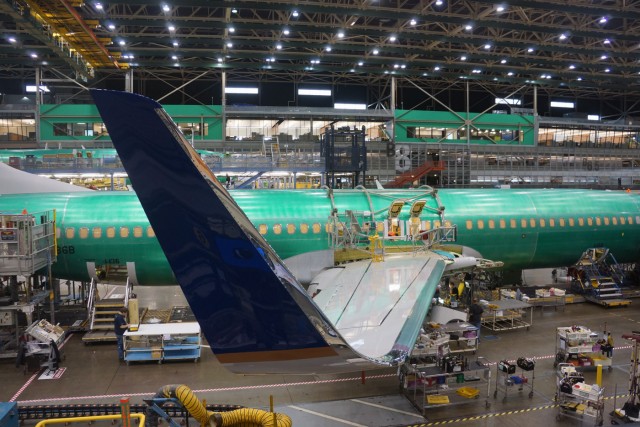
COPA Boeing 737 in the Renton Factory. Image by Chris Sloan.
This story was written by Chris Sloan and originally was published on Airchive.com. This is the next of a multi-part series talking about the Boeing 737 factory in Renton. Read the first part: A Historical Look at Boeing’s 737 Factory in Renton and second part: Inside Boeing’s 737 Renton Factory and the Successful Next Gen.
The Boeing 737 Goes Into ’œMAX’ Overdrive
The Boeing 737 NextGen order book continued to bulge, growing virtually unabated even through the deep worldwide economic slowdown / crisis of 2008-12. Ironically, this era of financial strife and sharply escalating fuel costs, as well as the growth of emerging markets, helped 737 and A320 sales go from strength to strength. Boeing however didn’t stand on it its laurels or did it?
Boeing claims with the introduction of its latest performance improvement package ’œPIP’, today’s NGs are 6-7 more efficient then when they were first introduced in the late 1990s. Boeing’s Tinseth points out that ’œThe (737) program has taken off with record sales. It’s simple. We make it better every time. We were first in its class with ETOPS 180, glass cockpits, Sky Interiors, and high bypass engines. We lower the operating costs through such new technologies as blended winglets, heads up display, carbon brakes, and more fuel-efficient engines. We enhance customer appeal with the new Sky Interior. This is an airplane that appeals to the heart of the market: emerging and developing economies and it is very successful with the LCC business model’. These new LCC airlines in emerging markets include Lion Air, Air Asia, and Gol! An unintended benefit of the weak economy, particularly in the U.S., is the poor financial results led to an elderly, fuel-in-efficient, maintenance intensive fleet which created an advantage and some say a bubble for airframe manufacturers, particularly in this sweet smart of the market. ’œThe significant driver in the US is the demand to replace older and less efficient aircraft’, said Tinseth.
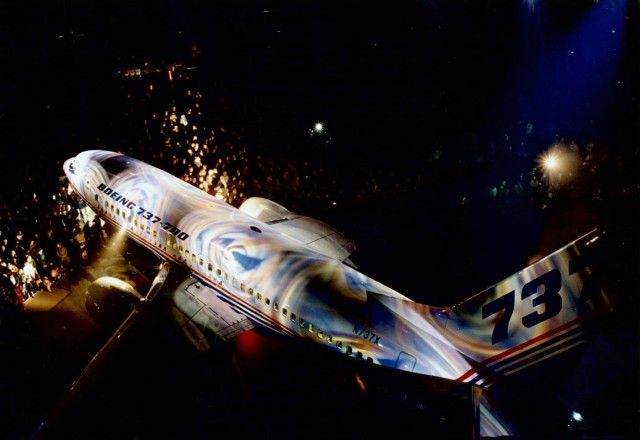
On December 2, 1996: The first 737NG, a 737-700, rolls out of the Renton factory to all splashy event. Image courtesy: Boeing
This story was written by Chris Sloan and originally was published on Airchive.com. This is the next of a multi-part series talking about the Boeing 737 factory in Renton. Read the first part: A Historical Look at Boeing’s 737 Factory in Renton.
Success Breeds Competition: The Airbus A320 ups the ante and Boeing is forced to answer
In 1988, the first serious competitor to the 737 monopoly, the Airbus A320 entered service. With even more advanced systems like fly-by-wire flight controls, new higher powered and fuel efficient engines, a wider cabin, the first major use of composite materials in a narrow body airliner, and somewhat larger capacity on a direct model comparison basis, the A320 family quickly became a force to be reckoned with. In addition, Airbus offered aggressive pricing and quicker delivery windows. Having only recently launched the 2nd generation 737s, Boeing didn’t respond to the European framer’s challenge for another 5 years.
In 1993, Boeing finally answered with the Boeing 737 Next Generation. First flying in 1997, it first entered service in 1998 as a 737-700 (comparable in size to the 737-300) for launch customer Southwest. While retaining commonality with the 2nd generation 737s, the NextGens included a redesigned wing, and eventually winglets, that increased total fuel capacity by 30% and range to over 3,000 miles. Quieter, more powerful and more fuel-efficient engines in the form of CFM56-7Bs came online as well.
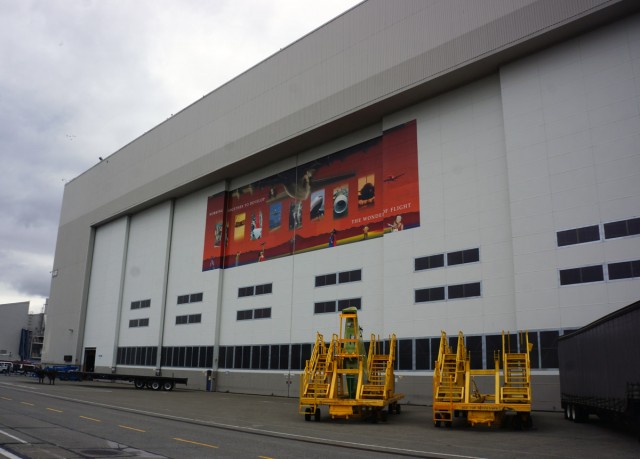
Outside the Boeing 737 Factory in Renton, WA. Photo by Chris Sloan / Airchive.com.
This story was written by Chris Sloan and originally was published on Airchive.com. This is the first of a multi-part series looking at the Boeing 737 factory in Renton.
On the evening of March 18, 2013 Boeing’s Renton Plant rolled out its first Boeing 737, a 737-800 bound for Panamanian Airline COPA, at the astounding new production rate of 38 aircraft per month. Boeing had only reached 35 airplanes per month, its previous historic high commercial production rate in January 2012. 2 days later on March 20, 2013, Boeing delivered the 7500th 737, the 7,229nd example built at Renton (more on this later). By Spring 2014, the rate is expected to leap to 42 aircraft per month.
In 2015, Renton will begin production of the new 737 MAX that is due to enter commercial service in 2017, 50 years after the 737 first entered service in 1967! The Boeing 737 is the best-selling and longest continuously produced commercial airliner of all time with over 10,500 deliveries and orders. As of April, 2013 between the new Max (1,234) and current the Next-Generation (4,395), the 737 backlog stands at 3,136 aircraft. With the increased production rates, the current order book will take 6 ½ years alone to clear. Boeing’s current market outlook estimates 23,000 new narrow body airliner orders in the 737 / A320 families category over the next 20 years. Three draw dropping data-points stand out:
- 40% of the world’s jetliner fleet has been manufactured at Renton.
- Renton has produced an astonishing total of over 15,000 aircraft making it one of the most prolific aircraft factories, and the most prolific jetliner factory in history.
- With approximately 5,600 737s in service, 25% of the world’s large jet fleet (non RJ) are Boeing 737s.
Previously I shared a guest blog from Vinay Bhaskara about the history of Air India. This is a continuation of his story, in his own words:
The Widebody Era
As Air India moved into the 1970s, it was in a wonderful position. Known for its superior service, Air India had managed to catch, not only a huge part of the Indian international travel market, but even a strong share of the Trans-Atlantic traffic between New York and London. They were one of the world’s most profitable airlines, as well as one of the most respected by other countries. Such was the opinion of Air India, that in 1972-1973, Singapore Airlines asked for Air India’s help in setting up its airline.
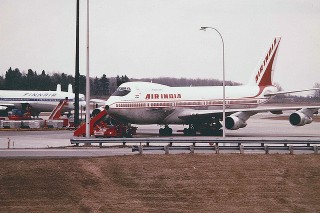
Air India's 747-200B "Samudra Gupta" sits at one of the remote gates at YMX preparing for it's long journey to Mumbai in May 1983. Photo from Caribb.
However, despite Air India’s sparkling reputation and solid operation, change was brewing in the world’s aviation market; change that would require bold action if the Maharaja was to continue in its prosperity. On January 22nd, 1970- Pan Am introduced widebody Boeing 747 service on the London-New York sector. Airlines around the world scrambled to catch up with Pan Am in introducing this new innovation. Despite strong opposition from Air India’s conservative board, there was really never a question in J.R.D Tata’s mind that Air India had to join the ’œ747 club,’ both for prestige reasons, and financial ones (competing as they did with Pan Am on New York-London, as well as European carriers and Asian carriers on the majority of their routes; Air India could ill afford to lose out on the added demand stimulated by lower fares, or the bump in passengers demanding the comfort of the 747). Through almost a sheer force of will, Tata was able to convince the board of the 747’s viability at Air India. Thus it was a moment of personal triumph for Tata when Air India’s first 747-200B (’œEmperor Ashoka’) announced its presence at London on May 24th, 1971, touching down at New York just two days later.
Air India would, at various times, operate 14 Boeing 747-200s, purchasing 11 brand-new from Boeing. During the 1970s, much of the focus was, predictably, on integrating the new aircraft successfully into Air India’s operation. The Boeing 747 presented enormous operational challenges for Air India; its sheer size made much of Air India’s ground equipment, as well as its maintenance and support operations essentially obsolete. Furthermore, while airports at the Londons and New Yorks of the world (where Air India would be operating their aircraft) had the necessary infrastructure in place to handle the Jumbo, taxiways, holding areas, and parking positions at Air India’s international gateways of Bombay and Delhi were woefully inadequate. But in an interesting contrast to today’s situation, the socialist-leaning Indian government of that time quickly acceded to Air India’s demands; building up the necessary infrastructure at not only Bombay and Delhi, but Madras and Calcutta as well. Air India was even able to build brand new maintenance hangars and support buildings at Bombay with a minimum of red tape. Air India’s mechanics at the time had an extraordinary reputation for quick, efficient and thorough quality service; leading many a third world carrier to schedule a stop in Bombay for maintenance purposes.
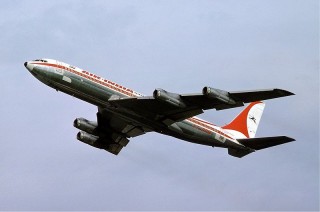
Air India Boeing 707. Photo from Wikipedia.
Given the enormous complexity added to Air India’s operation by the 747s, it is not surprising then that the airline limited its expansion during the first half of the 1970s. The first priority was to upgrade their highest-traffic routes to the 747s. By the summer of 1978, that goal had been achieved- with daily service to New York JFK, double daily to London-Heathrow (one of which continued to New York JFK), and daily service on the Tokyo route all performed on the 747-200Bs. During this transitions period, Air India wisely restricted its network growth; simply adding new destinations close in. The most notable of these was service to Dhaka, capital of the (relatively) new nation of Bangladesh. Service to Dhaka on 707s was begun on February 4th, 1972 and in November of that year; Osaka was added as an intermediate stop to the Tokyo route. Meanwhile, the Gulf market continued to grow in leaps and bounds, as new found oil wealth drove Middle Eastern nations to import migrant South Asian workers in droves. The important oil destinations of Muscat and Doha were added during the mid 70s, and frequencies to Gulf points increased heavily. Later in the decade, Baghdad and Ras al Kaminah also joined the Gulf portfolio. African growth was more limited, with mid-decade additions of the Seychelles (on the Mauritius route), Lagos, and Accra.
To this date, very few aviation entrepreneurs have been as involved in the day to day operations of their airline as J.R.D Tata. Air India’s scion, who had guided Air India to profitability in all but 3 years during his tenure, was one of the aviation industry’s foremost personas; on par with C.R Smith of American Airlines or Eddie Rickenbacker at Eastern Air Lines. However, in early 1978, it was announced that Tata would be stepping down as chairman by the end of that year. Before he exited however, Tata made one final mark on the aviation world; proving that he still had one of the sharpest minds in all of India. In a landmark speech on the 23rd of January 1978, Tata predicted that in the future, there would be a twin deck 750 seat mainline aircraft, that a long haul, low cost carrier akin to Laker Airways would flourish, and that future growth rates in the airline travel industry would average around 6%. He also cast doubts on the viability of the Concorde.
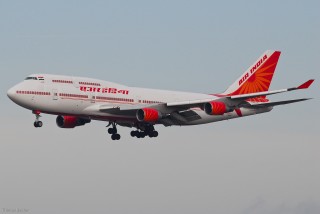
Air India still flies the Boeing 747 today. Photo by Thomas Becker.
On all four points, he was eventually proved correct (Airbus A380, AirAsia X, the test of time, and just 20 built). Having thus left his mark on Indian aviation, Tata rode off into the sunlight (literally- he re-enacted the first Karachi-Mumbai flight flown by Air India using an old Leopard Moth) and let his successor P.C Lal take the helm. The last two years of the decade provided very little in way of expansion; the major change was the introduction of direct services between South India and the Gulf. The majority of migrant workers in the Middle East were from Southern India, and Air India recognized this by introducing nonstop services- the first of which was Trivandrum-Dubai in 1978. Gulf routes represented the majority of Air India’s expansion in the latter half of the decade, and when Raghu Raj took over as chairman in April of 1980; Air India’s route network looked much as it did in 1975.
While Air India soared to great heights with the 747, Indian Airlines was entering the widebody age as well, though not on as grand a scale. Indian entered the 1970s as a troubled carrier. Of its numerous problems, a few were common with other airlines, but most were especially because of Indian Airlines’ home country; India. While these problems were certainly not insurmountable alone, when taken collectively, they represented a significant handicap to Indian Airlines’ progress.
* Indian Airlines was faced the constant threat of local wars between Pakistan and India. As the internal national carrier; Indian Airlines was responsible for providing transport and logistics during major conflicts. Therefore, operations were often interrupted, and lengthy periods existed where Indians traveling between cities had to divert to rail connections. Flights to rescue refugees (such as in Uganda in 1972) were less prevalent, but still diverted the carrier’s resources (Indian Airlines was required to perform these flights for free).
* As was common with national carriers, Indian Airlines was required to provide social services to underdeveloped and poor regions. These routes were rarely, if ever, subsidized by the government, and Indian Airlines was forced to cross-subsidize these routes with more profitable, big-city services; seriously depressing financial results. (Interestingly enough, one of the arguments in the recent Emirates and Canada brouhaha was that Emirates should not be given access to Canada because that would harm Air Canada’s international services, which supposedly cross-subsidized domestic routes to remote locations)
* As a corollary to the statement above, Indian Airlines was forced to serve multiple unprofitable points in the Northeast of India, where diversions due to a necessity to avoid East Pakistan (what Bangladesh was called before it got its independence, which in 1971 solved the to-be-mentioned problem) caused Indian Airlines’ fuel bill to become unsustainably high
* India as a market has always faced high fuel prices ’“ thanks to import duties, sales taxes, and a lack of domestic production. For Indian Airlines, the high price of fuel heavily limited profitability, especially when the carrier was flying a (relatively fuel inefficient fleet).
* When the IAC was formed in 1953, labor rates in India were abysmally low (a by-product of India’s previously colonial-style economy). But due to Indian Airlines’ high structural costs, the airline could ill-afford to satisfy its employees’ demands for higher wages. With little wage growth, strikes and work stoppages were common; disrupting operations further.
* As a by-product of a merger of 8 different carriers, Air India had multiple maintenance bases (4; Bombay, Delhi, Chennai, Calcutta). This complicated scheduling, and increased costs by a significant margin. When coupled with the aforementioned strikes; it is safe to say that Indian Airlines did not have the same operational reputation as Air India.
Given this veritable laundry list of problems, it is surprising that Indian Airlines was even able to survive at all. It really is a credit to the airline’s spirit at that time; and Indian Airlines showed a resiliency that would sustain it till the very end (a.k.a the merger with Air India in 2011).
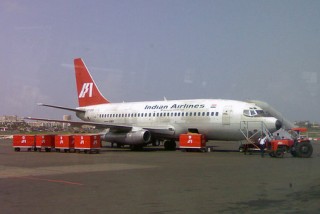
Indian Airlines Boeing 737-200. Photo by Tripping in India
The years 1971-1973 were very bad for Indian Airlines. The 1971-1972 Pakistan War caused operational interruptions and numerous problems, as mentioned above. This led the airline to report a 45 million rupee loss in 1973, the carrier’s largest to that point. And that may have been the best news to come out of 1973; as a series of crashes and work disruptions made life for Indian Airlines a ’œliving hell.’ On May 31st, a 737 crashed in a fierce Delhi storm, while a Caravelle, 2 HS 748s, and a Friendship all had to be taken out of service as well. But in spite of heavy scheduling demands, Indian Airlines was slow to put these aircraft back into service due to the illogical structure of their maintenance operations.
Exacerbating the aforementioned crises was the continual strike being waged by labor. Management, concerned by growing labor costs and inefficiency, eventually locked out many of its workers, operating only a skeleton schedule with a non-union workforce. It was against this backdrop that Indian Airlines ended the Night Air Mail Service, a service utilizing Nagpur in Central India as a hub to exchange mail between major Indian cities, after 24 years of continuous service. Additionally, all but two of the Vickers Viscounts were retired; all but ending the service run of India’s first true mass-transport aircraft. Eventually, Indian Airlines negotiated a new deal with its staff that kept wages flat while simultaneously making work rules and management-labor interactions more flexible.
With the labor situation stabilizing, Indian Airlines then moved to improve the financial performance of its operations. On February 1st 1974, fares were increased by 25% across the board; an action that was followed by the retirement of the last 30 Douglas DC-3s. The DC-3s had been present since the formation of Indian Airlines, and had served a variety of purposes; serving small dirt and gravel strips, performing airlifts and refugee flights, and acting as a quick substitution for Indian Airlines’ numerous aircraft losses. While fuel costs were certainly high with the DC-3s, the reliability of the aircraft was top-notch and no other aircraft could perform the DC-3’s exact function. This unique versatility was corroborated by the fact that upon the retirement of the DC-3s, 16 stations previously served by Indian Airlines were entirely closed down, as the Fokker Friendships could not reliably operate into these airports.
The dramatic sideshow of Indian Airlines’ regional operations sometimes overshadowed the fact that the carrier served a growing demand base on its trunk routes. Throughout the middle part of the decade, Indian Airlines re-grouped and stabilized, allowing it to take the bold and historic step of ordering 3 Airbus A300 widebodied aircraft in April of 1975. These aircraft would be used on Indian Airlines’ primary trunk routes, on which the 737s were regularly traveling full.
Recognizing that domestic demand in India was more about volume than premium business, Indian Airlines planned for the new Airbuses to be configured in a 278 seat all-economy class offering, with 33 inches of seat pitch. Even with demand booming however, widebody aircraft were very expensive to acquire and operate, so Indian Airlines smartly negotiated a deal with Airbus to reduce the price of the aircraft by a collective $2.4 million by shifting the manufacture of key ground service components to Indian factories.
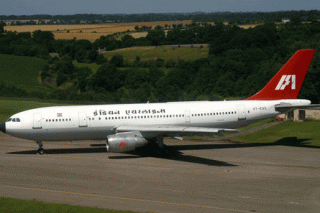
Indian Airlines Airbus A300.
External events caused the new A300s to be delivered much earlier than planned. In October of 1976, yet another Caravelle had crashed; causing the entire fleet to be grounded temporarily. Thus, Indian Airlines inaugurated service of the A300B-2s on December 1st of that same year, taking delivery of all 3 initial frames by mid January. These aircraft quickly began serving the Bombay-Delhi-Calcutta-Madras ’œdiamond,’ as well as Bangalore, stretching the 3 aircraft to their utilization limits. Loads were very good, consistently surpassing the 90% mark, and on-board service was upgraded a notch with more flight attendants per seat and a new selection of fine Indian cuisine.
Indian Airlines was primarily a domestic airline; with the vast majority of its flights operating within the confines of India’s 28 (+7) states. But given the fluid political situation of the Indian sub-continent; it was deemed better for Indian Airlines to provide air services to India’s immediate neighbors; namely Pakistan, Nepal, Bangladesh, Afghanistan, Burma, and so on. Keeping Air India on longer haul routes ensured that the valuable Air India brand was not tainted by unrest on the sub-continent. But for Indian Airlines, its international services were a point of pride, and so the carrier faithfully restored service to Karachi, Lahore, Dhaka, Kabul, and the like after every conflict. Given the state of the region’s other national carriers, such as PIA, Biman, and Ariana; Indian Airlines often represented the first step in normalized relations in the subcontinent. International operations grew in scale, albeit slowly, and by the end of the decade Indian Airlines was serving Dubai and Muscat in the Gulf.
Thus concludes Part 2 of the history of Air India. At this point I’d like to give a huge shout out to perhaps my best source; Airlines of Asia by R.E.G Davies. While I’ve certainly used other sources to write this piece; the basic events, and the idea for the story were both based on Mr. Davies’ book. R.E.G Davies is perhaps the greatest aviation historian of all time, and I encourage you all to find more of his books. It would be a great way to pay homage to his memory (Mr. Davies passed away on July 30th of this year).
